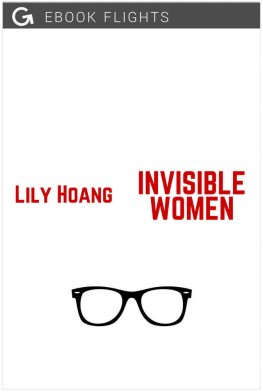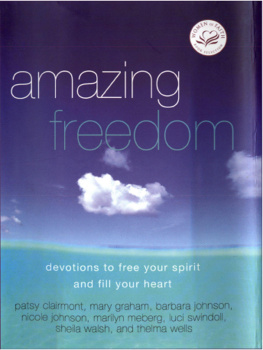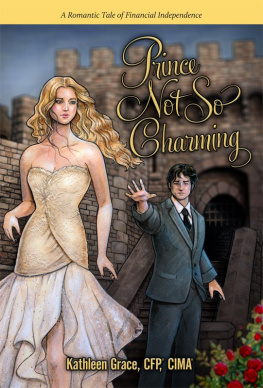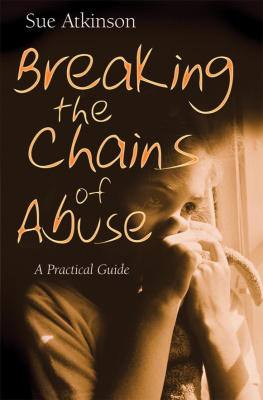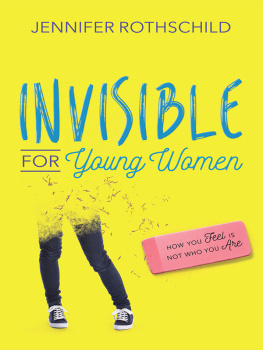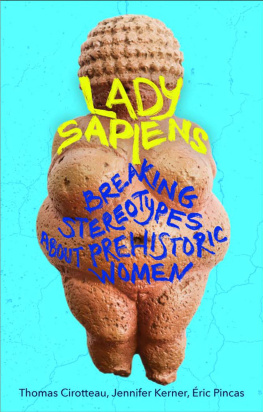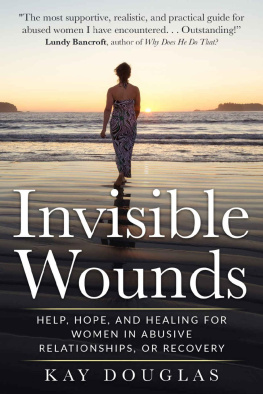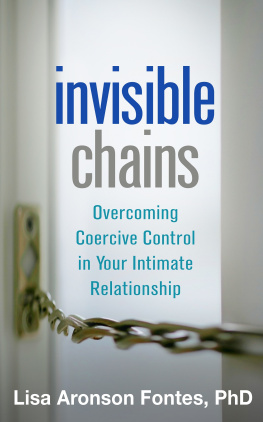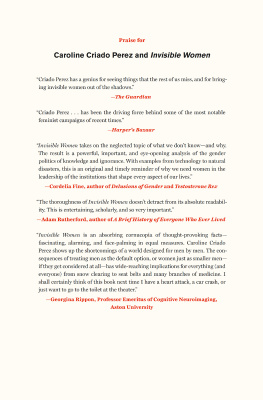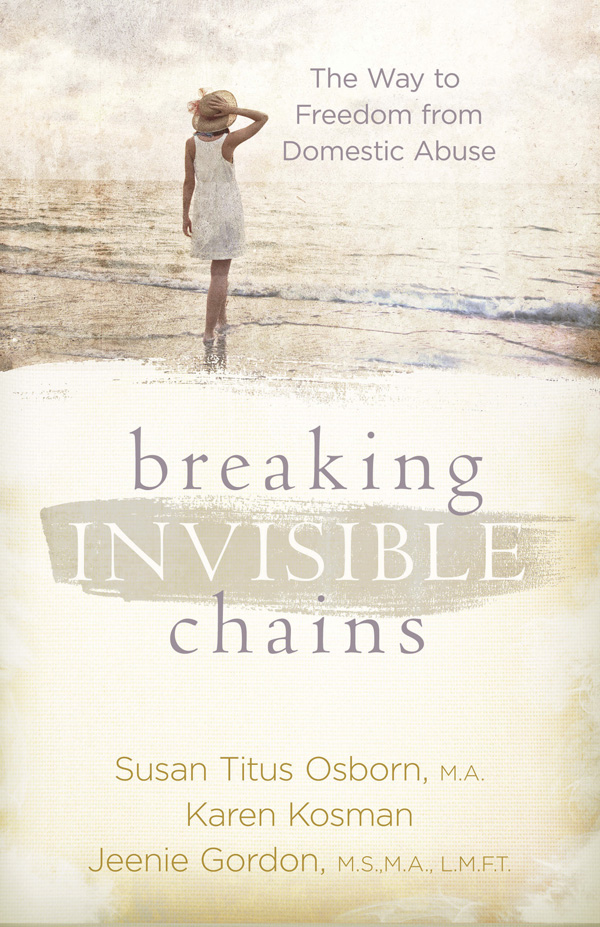For anyone who has carried chains forged by emotional or physical abuse, the promise of this book can seem impossible. Yet I urge you to pick up this book and read just the first few chapters. Youll end up reading it all yourself, like I did, and thinking of a dozen people who need to read it as well. The honesty, insights, and spiritual truth that come from these reality-soaked stories show that chains really can be broken. Love, hope, freedom, and the ability to build healthy relationships can be yourseven if youve come from the most broken, difficult background. And if you work, live, or minister to people who carry these chains you must read this book.
JOHN TRENT, PHD, president,
The Center for StrongFamilies and StrongFamilies.com
author of The Blessing and The 2 Degree Difference
Breaking Invisible Chains reveals the agonizing reality of emotional pain while pointing people to healing and hope. I highly recommend this book!
CAROL KENT, speaker and author of When I Lay My Isaac Down
and Between a Rock and a Grace Place
Its never easy to talk about domestic abuse. Thats why its important to read true stories like these and meet real women who felt trapped with nowhere to turn. They are here to tell you those chains can be broken. If you are silently suffering, this book will show you the way out. If you know someone in an abusive situation, this book will give you the courage to speak the truth in love. With Gods compassion as their guide, each author and contributor offers practical advice and genuine hope.
LIZ CURTIS HIGGS, best-selling author of Bad Girls of the Bible
Other New Hope books by
Susan Titus Osborn, Jeenie Gordon, Karen Kosman
Wounded by Words: Healing the Invisible
Scars of Emotional Abuse
Too Soon to Say Goodbye: Healing and
Hope for Victims and Survivors of Suicide
The Way to
Freedom from
Domestic Abuse
breaking
INVISIBLE
chains
Susan Titus Osborn, MA
Jeenie Gordon, MS, MA, LMFT
Karen Kosman

New Hope Publishers
P. O. Box 12065
Birmingham, AL 35202-2065
NewHopeDigital.com
New Hope Publishers is a division of WMU.
2013 by Susan Titus Osborn, Jeenie Gordon, Karen L. Kosman
All rights reserved. First printing 2013.
Printed in the United States of America.
No part of this publication may be reproduced, stored in a retrieval system, or transmitted in any form or by any meanselectronic, mechanical, photocopying, recording, or otherwisewithout the prior written permission of the publisher.
Library of Congress Product Control Number: 2013943702
All Scripture quotations, unless otherwise indicated, are taken from the HOLY BIBLE, NEW INTERNATIONAL VERSION, NIV Copyright 1973, 1978, 1984, 2011 by Biblica, Inc.TM Used by permission. All rights reserved worldwide.
Scripture quotations marked NLT are taken from the Holy Bible, New Living Translation, copyright 1996. Used by permission of Tyndale House Publishers, Inc., Wheaton, Illinois. All rights reserved.
Interior Design: Glynese Northam
ISBN-10: 1-59669-386-X
ISBN-13: 978-1-59669-386-9
N134127 0813 3M1
Table of Contents
To the outside world a person suffering from emotional hurts usually appears normal and happy. It would be much too shameful to admit to family and friends that abuse was occurring. It is much harder, however, for victims to keep their secrets from their own children, who often suffer in silence.
A newlywed looks forward to a happy marriage, filled with romance. She believes the fairy tale that they will live happily ever after. But in some marital relationships, the dark shadow of abuse begins within the first year, and gradually escalates.
I promise to love, honor, and cherish are beautiful words spoken in a wedding ceremonywords said in love that have now dissolved into doubt and regret. Abuse escalates over time. Dreams crumble into a nightmarish existence.
The victim becomes more and more fearful of her mate or boyfriend. As abuse increases, so does fear. Like a smothering blanket, it suffocates, isolates, and dominates. Fear imprisons and overpowers the persons ability to think rationally.
Children and teens may become deeply scarred by seeing their father mistreat their mother or by being abused themselves. As teens, they may act out the abuse in dating relationships. As a result, they often suffer from mental and emotional scars that have a long-term effect.
As the abuse escalates, a woman may feel trapped, but she is afraid to share with others what is happening. Life becomes a daily cycle of stress and fear. Her health and well-being are in jeopardy.
The reality of an abusive lifestyle is often slow to surface. The victim tries to rationalize her situation with self-talk, which may include disbelief and self-blame. It is vital that she realizes that she is being abused and that she begins to seek help.
The victim needs to take off her mask and share with a friend or family member the abuse that is happening in her home life, or she may share with a pastor, or seek psychological guidance.
Victims often suffer from low self-image, experience self-doubt, and have feelings of worthlessness. They mistakenly think they deserve the abuse and are often frozen in an unhealthy state as the result of cruel mistreatment. And unfortunately, many still want to protect their abuser.
God has promised that the truth will set us free. The victim vows to have no more secrets and not to put up with any more abuse. She finally faces the truth and admits what is happening in her life. With the help and advice of a Christian therapist, a minister, family member, or a friend, she vows to change her circumstances.
The abused woman begins the road to restoration. She may turn to a shelter that offers a safe place for victims of domestic abusea place where hopes are renewed. She may go to counseling and find the freedom to express hidden fears. She begins to put her life back together through friends, family members, specialists, and a restored faith in the Lord.
The victim learns to get on with her life. God has removed the chains of domestic abuse, freeing her to live again. She is no longer fearful or worried. Home once more becomes a safe, peaceful place. Each day brings a new opportunity for her to attend classes, find a new job, renew friendships, and embrace a closer relationship with the Lord.
ACKNOWLEDGMENTS
We would like to thank Lieutenant Tom Tarpley, Special Operations Division commander, Tustin, California, Police Department for his valuable expertise and input for this book. We would also like to thank the 22 authors who contributed stories regarding their own experiences or the experiences of their clients. Many of the names in the stories and of the authors have been changed. Without the input of these valuable people, this book could not have been written.
Dedication
This book is dedicated to those individuals who have suffered from emotional hurts, verbal and physical abuse, and domestic violence. May they find hope, wholeness, and peace in our Lord Jesus Christ through the pages of this book.
Introduction
Emotional hurts and domestic abuse can happen to anyone. They occur in all age ranges, ethnic backgrounds, and economic levels. It happens to ordinary women who dared to love, but later discovered that the man they married was completely different from the man who courted them. Over time, an abusive partner strips these women of their self-esteem as the darker side of their spouses or boyfriends becomes more evident. This can lead to anxiety and depression and make the victims feel helpless and alone. As the years go by, their abusers belittle and sometimes beat them to the point of threatening their lives.


